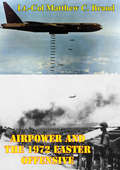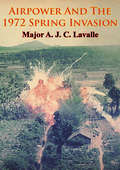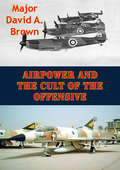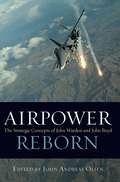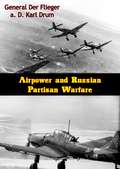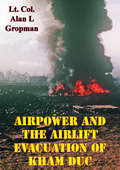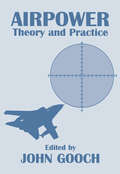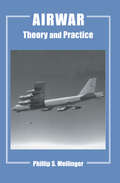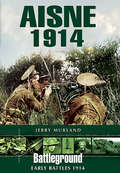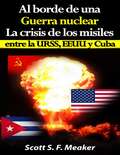- Table View
- List View
Airpower And The 1972 Easter Offensive
by Lt.-Col Matthew C. BrandIn the spring of 1972, North Vietnam launched a massive, three-pronged attack into South Vietnam that was eventually repulsed by South Vietnamese forces, United States (US) advisors and massive amounts of American airpower. The problem is determining what factors were key to South Vietnam's successful defense. To that point, this thesis will address the overall effectiveness of US airpower in defeating North Vietnam's attack. This paper first examines the strategic and operational environment surrounding the 1972 offensive, including the role and influence that the leaders of the US, Saigon, Hanoi, China, and the Soviet Union had on the conflict. It then shifts to the three primary tactical battles, describing each in detail, from the initial communist successes to their ultimate defeat. Finally, the analysis focuses specifically on airpower's role, from the massive strategic deployment that doubled the available assets in theater in just over a month, to its operational success striking targets in North Vietnam, to its tactical successes on the various battlefields of South Vietnam. Ultimately, this analysis determines that US airpower, with US advisors playing a critical enabling role, was the decisive element in the defeat of North Vietnam's Easter Offensive.
Airpower And The 1972 Easter Offensive
by Lt.-Col Matthew C. BrandIn the spring of 1972, North Vietnam launched a massive, three-pronged attack into South Vietnam that was eventually repulsed by South Vietnamese forces, United States (US) advisors and massive amounts of American airpower. The problem is determining what factors were key to South Vietnam's successful defense. To that point, this thesis will address the overall effectiveness of US airpower in defeating North Vietnam's attack. This paper first examines the strategic and operational environment surrounding the 1972 offensive, including the role and influence that the leaders of the US, Saigon, Hanoi, China, and the Soviet Union had on the conflict. It then shifts to the three primary tactical battles, describing each in detail, from the initial communist successes to their ultimate defeat. Finally, the analysis focuses specifically on airpower's role, from the massive strategic deployment that doubled the available assets in theater in just over a month, to its operational success striking targets in North Vietnam, to its tactical successes on the various battlefields of South Vietnam. Ultimately, this analysis determines that US airpower, with US advisors playing a critical enabling role, was the decisive element in the defeat of North Vietnam's Easter Offensive.
Airpower And The 1972 Spring Invasion [Illustrated Edition] (USAF Southeast Asia Monograph Series #2)
by Major A. J. C. LavalleIllustrated with over 30 maps, diagrams and photosIn our continuing desire to bring to the reader an in-depth look at the use of airpower in Southeast Asia, we present. In this volume a truly monumental effort at recounting the myriad of widely separate but not unrelated events and operations that took place during the spring invasion of 1972.In this monograph, the authors from the Air War College present an illuminating story of the people and machines that fought so gallantly during this major enemy offensive. The authors' breadth of experience in and out of combat enables them to provide a penetrating account of how airpower was brought to bear upon the enemy.The "Vietnamization" program, begun in 1969, had by March of 1972 reduced U. S. manpower involvement in Vietnam from 500,000 to 95,000. U. S. airpower involvement, however, did not decrease proportionately. Although the South Vietnamese Air Force took up the "lion's share" of the effort, U. S. airmen were still very much involved. During the offensive, their skills, courage and professionalism were tested 24 hours a day, directly contributing to the eventual successful outcome.The reader should learn from this story that not only is airpower an essential element of any major operation, but that its employment is a team effort. More so, it involves men and women on the ground as well as in the air-one cannot function without the other.
Airpower And The Cult Of The Offensive
by Major John R. CarterThe belief that airpower is inherently offensive is a recurrent theme throughout airpower theory and doctrine. Before World War I, dogmatic belief in the dominance of the offense in land warfare affected the military decisions which resulted in the disaster of the trenches. Termed the "cult of the offensive" by scholars, faith in offense became so unshakable in pre-1914 Europe that military organizations dismissed as irrelevant the numerous indications of the waning power of the offense as technological developments strengthened the defense. With airpower's professed inclination for offense, could a cult of the offensive perniciously trap airpower doctrine and lead to similarly disastrous consequences?The study begins by establishing the theoretical background necessary for case study analysis. Airpower defense is defined as those operations conducted to deny another force's air operations in a designated airspace. Airpower offenses are those operations in the airspace defended by another, or operations conducted outside of one's actively defended airspace. The relationship between offense and defense is dissected to discover that airpower defense enjoys neither an advantage of position nor of time, so traditional Clausewitzian views relative to the power of the defense do not apply to airpower. Next, the study describes those factors which may inject, or reinforce, a preferential bias for offense into airpower strategy and doctrine. A cult of the offensive is defined as an organizational belief in the power of offense so compelling that the military organization no longer evaluates its offensive doctrine objectively. This leads to an examination of the ramifications postulated to result from offensive ideology.
Airpower Employment Of The Fifth Air Force In The World War II Southwest Pacific Theater
by Major James A. BarrThis research project studies the employment of airpower by the Fifth Air Force, under Gen George C. Kenney, in the Southwest Pacific Theater during World War II. The research began with two basic assumptions. First, it assumed that the strategic bombardment theory developed by the Air Corps Tactical School in the 1930s was the definitive doctrine of the Air Corps upon entry into World War II. Second, it assumed that General Kenney and his staff were required to develop a new doctrine for airpower employment since the situation in the Southwest Pacific did not lend itself to strategic bombardment of the Japanese industrial web. The research process proved both of these assumptions invalid.Study of historical records, personal accounts, and subsequent historical writings in several areas revealed that there was no clear and consistent doctrine for the employment of airpower...General Kenney assumed command of the Fifth Air Force with a clear vision of how to employ air forces to defeat the enemy. His diverse background gave him a balanced view of the roles airpower should play, and he was not convinced by the strategic bombardment theory that claimed invincibility for the bomber. His World War I experiences and teachings at the Air Corps Tactical School provided a strong belief in the importance of air superiority and attack aviation. He was innovative in modifying tactics and equipment, and in developing new roles for airpower as the situation dictated...This study surveys the development of airpower doctrine beginning with World War followed by major developments during the interwar period in several arenas. It then looks at the varied aspects of Gen George C. Kenney's career which prepared him to command the Fifth Air Force in the Southwest Pacific Theater during World War II. Finally, it considers General Kenney's employment of airpower in light of the pre-war doctrine development.
Airpower Reborn
by Edited by John Andreas OlsenAirpower Reborn offers a conceptual approach to warfare that emphasizes airpower’s unique capability to achieve strategic effects. Six world-leading theorists argue that a viable strategy must transcend the purely military sphere, view the adversary as a multi-dimensional system, and pursue systemic paralysis and strategic effects rather than military destruction or attrition. The book is divided into three parts. The first section presents a historical perspective on airpower theory and airpower strategy, tracing their evolution from the 1920s to the 1980s. The second section contains in-depth examinations of the strategic concepts that John R. Boyd and John A. Warden developed in the 1980s and 1990s, with an emphasis on their contemporary relevance. The final section provides further context on modern airpower theory and strategy. Theory, in this setting, serves as the basic paradigm, strategy represents its generic, mechanisms-centered application, and plans of campaign constitute the specific steps for any given situation. In short, the authors look beyond the land-centric, battlefield-oriented paradigm that has continued to dominate military theories and strategies long after airpower offered new options. The book acknowledges the essential role of advanced technology in improving airpower capabilities, but emphasizes that air services must cultivate and harness the intellectual acumen of airmen and encourage officers and men to think conceptually and strategically about the application of aerospace power. Modern airpower can offer political decision-makers more and better options--provided the underlying strategy coherently links the application of airpower directly to the end-state objectives rather than limiting it to "the battle. ” The book recommends that all countries should consider establishing a dynamic and vibrant environment for mastering aerospace history, theory, strategy, and doctrine; a milieu for cultivating broader knowledge of and insight into airpower; and a setting in which airpower experts have the opportunity to communicate their narrative to politicians, the media, and fellow officers, and to interact to mutual benefit with experts from all sectors of governance. This effort should emphasize the potentially unique contribution of airpower to political objectives and joint operations, and in turn connect to operational headquarters that do operational planning. Mastering such strategic thought lies at the heart of the military profession, but it requires in-depth knowledge and understanding of theory, strategy, and airpower, and transcends traditional metrics.
Airpower Support To Unconventional Warfare
by Major Scott A. HartmanWith the development of the "long war," the U.S. military's focus has shifted dramatically from its traditional emphasis on conventional operations to irregular and indirect approaches to safeguard America's vital interests. One of the least understood aspects of Irregular Warfare is Unconventional Warfare (UW), which includes operations conducted through, with or by indigenous forces and provides the U.S. with an indirect means of accomplishing its objectives.This thesis examines the current ability of Special Operations Forces to conduct UW with air support, specifically air support provided by Air Force Special Operations Command (AFSOC). This thesis examines the questions--Does AFSOC currently have airpower assets with the capability to support UW operations with mobility, resupply, and fires?Three case studies were used to examine airpowers role in UW: Allied support to the French resistance in WWII, United States support to the Hmong during the conflict in Laos and a hypothetical scenario using AFSOC's current capabilities. The three case studies were examined using the evaluation criteria of effectiveness, efficiency and unity of effort. The analysis found that AFSOC could currently support UW operations, but effectiveness would be limited by a number of factors.
Airpower and Russian Partisan Warfare
by General Der Flieger a. D. Karl DrumAirpower and Russian Partisan Warfare, written by General der Flieger a. D. Karl Drum and first published in 1962, is one of a series of historical studies written by, or based on information supplied by, former key officers of the German Air Force for the United States Air Force Historical Division.The overall purpose of the series is threefold: 1) To provide the United States Air Force with a comprehensive and, insofar as possible, authoritative history of a major air force which suffered defeat in World War II; 2) to provide a history of that air force as prepared by many of its principal and responsible leaders; 3) to provide a firsthand account of that air force’s unique combat in a major war with the forces of the Soviet Union. This series of studies therefore covers in large part virtually all phases of the Luftwaffe’s operations and organization, from its camouflaged origin in the Reichswehr, during the period of secret German rearmament following World War I, through its participation in the Spanish Civil War and its massive operations and final defeat in World War II.
Airpower and the Airlift Evacuation of Kham Duc [Illustrated Edition] (USAF Southeast Asia Monograph Series #5)
by Lt.-Col. Alan L. GropmanIllustrated with over 30 maps, diagrams and photosTHIS slender volume has value for both the general reader and the aviation specialist. For the latter there are lessons regarding command and control and combined-unit operations that need to be learned to achieve battlefield success. For the former there is a straightforward narrative about American aviators of all four services struggling in the most difficult of conditions to try to rescue more than 1,500 American and Vietnamese military and civilians. Not all the Americans moving through the events recounted in this monograph acted heroically, but most did, and it was their heroism that gave the evacuation the success it had.Airpower and the Airlift Evacuation of Kham Duc is fully documented so that readers wishing to look deeper into this incident may do so. Those who study the battle will see that it was something of a microcosm of the entire Vietnam War in the relationship of airpower to tactical ground efforts. Kham Duc sat at the bottom of a small green mountain bowl, and during most of 12 May 1968 the sky was full of helicopters, forward air controller aircraft, transports, and fighters, all striving to succeed and to avoid running into each other in what were most trying circumstances. In the end they carried the day, though by the narrowest of margins and with heavy losses.
Airpower: The Decisive Force in Korea
by Col. James T. Stewart“Without question, the decisive force in the Korean War was airpower. Through its unrelenting efforts in those dark days of the summer of 1950, U.S. and other U.N. ground forces were able to retain a foothold on the peninsula. During the three years of fighting that followed, defeat or victory often depended upon the successful accomplishment by the United States Far East Air Forces of the tasks laid upon them.“As yet completely unresolved are the roles land and sea forces must play and their relationship to airpower in the full exploitation of its destructive potential; but an understanding of those factors is vital to a proper assessment of the role of air forces in the Korean War.“Korea was a limited war in every sense of the word. There were economic restraints against the expenditures of precious resources which might weaken the U.S. worldwide stand against Communist aggression. There were political restraints against the use of certain weapons and forces. Fighting was limited to the confines of North Korea which precluded attacks upon the sources of enemy war-making materiels. Within North Korea itself: there were psychological restraints imposed upon the weapons used; moral restraints prohibited attacks for several years against lucrative target systems. In analyzing any aspect of Korea, it is important to remember that airpower was never charged with winning the war—nor were the ground forces after truce talks began.“This book is not intended as a comprehensive analysis of each facet of the air war. Neither is it an inclusive chronology of events. Its purpose certainly is not to question U.S. policy or to detract from the stature of any service which fought so valiantly in Korea. Rather, it examines certain individual facets of the air war to further a better understanding of airpower. It constitutes professional reading for military people and interesting reading for the layman.” (Col. James T. Stewart)
Airpower: Theory and Practice
by John GoochThe nine contributors to this volume study the rapid development of airpower during the twentieth century as well as the methodological problems involved in assessing such change.
Airwar over the Atlantic (Luftwaffe At War Ser.)
by Manfred GriehlLate in 1938, the German Navy Supreme Command commissioned a report into the combat effectiveness of its airborne divisions. As a result of its findings, the German High Command instigated a major construction program for planes with a specifically maritime role: carrier-borne, reconnaissance, mine laying and most importantly, long-range units were all developed. In this volume of the outstanding Luftwaffe at War series, Manfred Griehl showcases a photo-history of the development of the Kriegsmarine airborne capability from the early Condor missions to the introduction of Me 262 A-1a jet fighters in 1944. More than a hundred rarely seen pictures illustrate the gradual turning of the tide against Germany in the war for the skies over the Atlantic: as the German war machine struggled to match demand for aircraft, so the pilots attempting to control crucial supply routes struggled to compete with mounting allied technical and numerical superiority.
Airwar: Essays on its Theory and Practice (Studies In Air Power Ser. #Vol. 14)
by Phillip S. MeilingerAccording to the author all aircrews, tacticians and those who direct them have to realise the limitations of air power during conflicts. For years opinion has differed as to whether the aircraft has altered war strategies or merely the tactics of war. This volume explores the limits of airpower.
Airway to the East, 1918–1920: And the Collapse of No.1 Aerial Route RAF
by Clive SempleThe origins of what became officially known as No 1 Aerial Route lay in the newly formed Royal Air Forces desire to move several squadrons of the then recently designed first heavy bomber to enter service the Handley Page O/400, to the war in the Middle-East. The aircraft had served on the Western Front with some success, although not in the long-range capacity. During the spring of 1918, the Wing Commander of No 5 Wing, Billy Borton, requested that one of the HP O/400 aircraft be flown to Egypt. This was approved by Major General Sir Frederick Sykes. Before the flight could proceed a great deal of planning was required since the aircrafts maximum range was only 600 miles. Several refueling and maintenance bases along the route were required. When planned in 1918 the route was from Paris Lyons, Istres, Pisa, Rome, Barletta, Taranto, Athens, Crete, Mersa Matru and finally Cairo. Each landing station would require fuel, spares, and communications and back-up personnel. On July 50.00 1918 a new HPO/400 set off from Manston in Kent with Borton and his pilot Major McLaren plus two crew. After a comparatively trouble-free flight the bomber arrived in Aboukir, Alexandria on the evening of 7 August. As a result, the RAF decided to use this route to fly several squadrons of the Handley Page bombers shortly after the war had ended. The Arab leaders had found out that the Allies promise that the captured Turkish lands would be returned to them was a duplicitous lie and that France and Great Britain would take control of the area. This quite naturally lead to massive unrest and rioting throughout the middle-eastern lands. The bombers were needed to quell the rioting and sabotage that had broken out. Thus, on 3 May 1919 58 Squadron set of from France on No 1 Aerial Route. It was a premature departure since many of the refueling airfields along the route were not prepared for there incoming customers. Chaos ensued by 1 November Three Squadrons had been dispatched. Of the 51 bombers sent only 26 had arrived, ten were stuck en-route and 15 had been written-off as broken or lost at sea and 11 aircrew had perished.This is the story of the development of the route. It would eventually form the first stage of the Imperial Air Route to Australia.
Aisne 1914: The Bef And The Birth Of The Western Front (Battleground Early Battles 1914)
by Jerry MurlandThe 1914 Battle of the Aisne, officially from 12 15 September, came about as a result of the German retirement from the Battle of the Marne, which took place further south as the huge conscript armies of France and Germany jostled for position almost within sight of Paris. By the time the British arrived on the Aisne the battle line stretched some 150 miles from Noyon in the west to Verdun in the east and it was only along a tiny fifteen mile sector in the middle that the The British Expeditionary Force was engaged. However, it fought bitter engagements, which took place in difficult conditions and casualties were heavy. The Aisne fighting was the final attempt by the allies to follow through from the success of the Marne. It also marked the successful establishment by the Germans of a sound defensive line on this part of the front.As seen in 'Scale Military Modelling Monthly'.
Aisne 1918 (Battleground North West France)
by David BlanchardThis battlefield guide and history will focus mainly on the events of attack that fell on the British sector of the front between the 27th 1st June 1918, although the offensive which also befell the French forces will not be totally neglected. This area had been a French held sector since 1915 and the French had fought one of its major engagements of the war here in 1917, the ill-fated Nivelle Offensive. French monuments and cemeteries dominate the landscape. The British were also here in 1914, and they too have left reminders of their relative brief presence. However, the actions fought here early in the war tend to be found mainly to the west of the sector. The battlefield of May 1918 scales the heights of the Chemin des Dames ridge, along the Californe Plateau and descends to afforested valley of the Aisne river and canal. The retreat of the Britsh forces during the course of the first day and in following days extends further south almost to the Marne and takes in part of the Champagne region.
Ajax, The Dutch, The War: Football in Europe During the Second World War
by Simon Kuper'Football history at its best' SCOTLAND ON SUNDAY'Hugely moving... a very good book indeed' FOUR FOUR TWO'Kuper is an original, sophisticated and adventurous writer. The story he has to tell... is fascinating and pressing' SUNDAY TIMESIn FOOTBALL AGAINST THE ENEMY Simon Kuper crossed the globe in search of the links between football, politics and culture. In AJAX, THE DUTCH, THE WAR he skilfully pieces together an alternative account of World War II. He looks at the lives of the footballers who played for the Dutch club, the officials and the ordinary fans during this tumultuous period and challenges the accepted notion of the War in occupied Europe. With almost 80 per cent of Amsterdam's Jewish Corner wiped out during the war, the long-held belief that, by and large, half the Dutch population had some kind of link to the Resistance has, of late, come into question. Kuper explores this issue and looks deeper into the role of football across Europe in the years both preceding and following the War. The result is a compelling and controversial account of the War, seen through the lens of football.
Akin: A Novel
by Emma DonoghueThe next masterpiece by the New York Times bestselling author of Room: A retired professor's life is thrown into chaos when he takes his great-nephew to the French Riviera Noah Selvaggio is a retired chemistry professor and widower living on the Upper West Side, but born in the South of France. He is days away from his first visit back to Nice since he was a child, bringing with him a handful of puzzling photos he's discovered from his mother's wartime years. But he receives a call from social services: Noah is the closest available relative of an eleven-year-old great-nephew he's never met, who urgently needs someone to look after him. Out of a feeling of obligation, Noah agrees to take Michael along on his trip. Much has changed in this famously charming seaside mecca, still haunted by memories of the Nazi occupation. The unlikely duo, suffering from jet lag and culture shock, bicker about everything from steak frites to screen time. But Noah gradually comes to appreciate the boy's truculent wit, and Michael's ease with tech and sharp eye help Noah unearth troubling details about their family's past. Both come to grasp the risks people in all eras have run for their loved ones, and find they are more akin than they knew.Written with all the tenderness and psychological intensity that made Room an international bestseller, Akin is a funny, heart-wrenching tale of an old man and a boy, born two generations apart, who unpick their painful story and start to write a new one together.
Al Qaeda in the Islamic Maghreb: Shadow of Terror over The Sahel, from 2007 (History Of Terror Ser.)
by Al J. VenterInsurgencies in Iraq, Afghanistan, Syria, Yemen and elsewhere the majority linked to al Qaeda are in the news on an almost daily basis. But very little surfaces about a festering insurgency that has been on the go for six years in West Africa under the acronym of AQIM, or al Qaeda in the Islamic Maghreb. This low-level series of guerrilla conflicts is widespread and sporadic, covering an area as vast as Europe. Nigeria has been drawn into the equation because its Boko Haram insurgent faction maintains close ties with AQIM and Islamic State.For now though, the focus is on Mali where several jihadist groups despite formal peace agreements remain active. Involved is the French army and air force as well as the United Nations Multidimensional Integrated Stabilization Mission in Mali (MINUSMA), the European Union Training Mission in Mali (EUTM) as well as the European Union Capacity Building Mission (EUCAP).The insurrection that fostered all this broke out early 2012 when President Franois Hollande announced the beginning of Operation Serval. Five hours later the first squadrons of French Gazelle helicopter gunships began attacking Islamist columns. A day later French fighter jets based in Chad, almost 2,000 kilometers away, were making sorties against rebel ground targets in northern Mali.
Al Qaeda, The Islamic State, And The Global Jihadist Movement: What Everyone Needs to Kno
by Daniel BymanOn the morning of September 11, 2001, the entire world was introduced to Al Qaeda and its enigmatic leader, Osama bin Laden. But the organization that changed the face of terrorism forever and unleashed a whirlwind of counterterrorism activity and two major wars had been on the scene longbefore that eventful morning. In Al Qaeda, the Islamic State, and the Global Jihadist Movement: What Everyone Needs to Know, Daniel L. Byman, an eminent scholar of Middle East terrorism and international security who served on the 9/11 Commission, provides a sharp and concise overview of Al Qaeda,from its humble origins in the mountains of Afghanistan to the present, explaining its perseverance and adaptation since 9/11 and the limits of U. S. and allied counterterrorism efforts. The organization that would come to be known as Al Qaeda traces its roots to the anti-Soviet jihad in Afghanistan in the 1980s. Founded as the Soviets withdrew from Afghanistan, Al Qaeda achieved a degree of international notoriety with a series of spectacular attacks in the 1990s; however, it wasthe dramatic assaults on the World Trade Center and the Pentagon on 9/11 that truly launched Al Qaeda onto the global stage. The attacks endowed the organization with world-historical importance and provoked an overwhelming counterattack by the United States and other western countries. Within ayear of 9/11, the core of Al Qaeda had been chased out of Afghanistan and into a variety of refuges across the Muslim world. Splinter groups and franchised offshoots were active in the 2000s in countries like Pakistan, Iraq, and Yemen, but by early 2011, after more than a decade of relentlesscounterterrorism efforts by the United States and other Western military and intelligence services, most felt that Al Qaeda's moment had passed. With the death of Osama bin Laden in May of that year, many predicted that Al Qaeda was in its death throes. Shockingly, Al Qaeda has staged a remarkablecomeback in the last few years. In almost every conflict in the Muslim world, from portions of the Xanjing region in northwest China to the African subcontinent, Al Qaeda franchises or like-minded groups have played a role. Al Qaeda's extreme Salafist ideology continues to appeal to radicalizedSunni Muslims throughout the world, and it has successfully altered its organizational structure so that it can both weather America's enduring full-spectrum assault and tailor its message to specific audiences. Authoritative and highly readable, Byman's account offers readers insightful and penetrating answers to the fundamental questions about Al Qaeda: who they are, where they came from, where they're going-and, perhaps most critically-what we can do about it.
Al borde de una guerra nuclear. La Crisis de los Misiles entre la URSS, EEUU y Cuba.
by Scott S. F. Meaker J. I. FernándezEn los años 50, el gran temor se llamaba Guerra Nuclear. Para la Unión Soviética contar con un bastión comunista tan cerca de la frontera americana era un sueño hecho realidad. A principios de los 60, hubo grandes tensiones entre americanos y soviéticos. Además de la desastrosa pérdida de vidas y dignidad en la Bahía de Cochinos, sucedió algo más. La línea se marcaba firmemente en la arena. El mundo estaba al borde de una guerra nuclear.
Al-jabartai's Chronicle of The French Occupation 1798 (Napoleon in Egypt)
by Shmuel Moreh Al-JabartiWhen Napoleon descended upon Egypt in 1798 it was the first contact between a Western European power with imperial ambitions & the Arab world. Sheikh Al-Jabarti chronicled the occupation & has left a fascinating record of how the Arabs viewed the French enterprise.
Alabama and the Civil War: A History & Guide (Civil War Ser.)
by Robert C. JonesAn examination of the influence of the &“Heart of Dixie&” on the War Between the States—the key players, places, and politics. Alabama&’s role in the Civil War cannot be understated. Union raids into northern Alabama, the huge manufacturing infrastructure in central Alabama and the Battle of Mobile Bay all played significant parts. A number of important Civil War figures also called Alabama home. Maj. General Joseph Wheeler was one of the most remarkable Confederate cavalry commanders in the west. John the Gallant Pelham earned the nickname for his bravery during the Battle of Fredericksburg. John Semmes commanded two of the most famous commerce raiders of the war—the CSS Sumter and the CSS Alabama. Author Robert C. Jones examines the people and places in Alabama that shaped the Civil War. Includes photos!
Alam Halfa: A Study Of High Command
by LTC Charles J. SchwartzmanIn recent years the army has adopted rigorous programs which evaluate the competence and leadership abilities of its combat leaders. For the first time, senior leaders are being formally evaluated as they command their units in the simulated combat environment provided by the Battle Combat Training Program (BCTP). Preparation for BCTP will require introspection and thought as the commander develops his concept of the operation and establishes the vision to guide his organization. This paper can assist the commander in this effort by challenging his thought processes and by provoking him to find answers to the problems of command. It describes the Battle of Alam Halfa which was fought in North Africa in 1942. It is appropriate because its major participant, General Bernard Montgomery, had a uniquely "BCTP-type" mission. He was expected to assume command, imprint his methods and procedures on his army, and fight a major battle within a two-week period. The study includes an overview of the following: the situation in North Africa during the summer of 1942; the steps Montgomery took to prepare his force for battle; and the fighting itself. It concludes with an analysis of the battle using the AirLand Battle imperatives.
Alamein
by Stephen BungayFrom the author of The Most Dangerous Enemy, a study of the history, strategy, and logistics of the pivotal World War II battles at El Alamein.El Alamein was the Second World War land battle Britain had to win. By the summer of 1942 Rommel’s German forces were threatening to sweep through the Western Desert and drive on to the Suez Canal, and Britain desperately needed a victory.In July, Rommel was halted. Then, in October, after twelve days of attritional fighting, Montgomery’s Eighth Army broke through the German and Italian lines at El Alamein. It was a turning-point in the war after which, in Churchill’s words, “we never had a defeat.”Stephen Bungay’s superbly readable narrative complements his definitive study of the Battle of Britain, The Most Dangerous Enemy, illuminating every aspect of this most famous episode of the Desert War, from the crucial logistics of keeping the distant armies supplied to the terror of battle in tormenting heat that was the soldier’s war.Praise for Alamein“Terse and brilliantly written by a thorough master of his subject.” —John Lukacs, Los Angeles Times“A brilliant balance between lucid analysis and piquant detail . . . masterly chapters.” —Lawrence James, Daily Mail (UK)“A broad and pacy overview in a short compass.” —Hew Strachan, Times Literary Supplement (UK)
